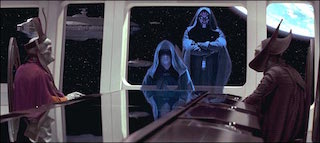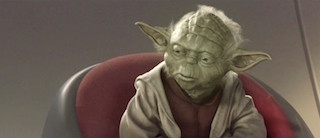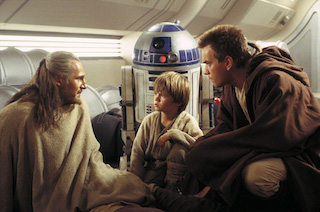In 1999, Star Wars fandom had risen to the highest tide since the 1983 release of Return of the Jedi. This wasn’t the re-release of the special editions in theaters from a few years previous. Nope, this was a brand new Star Wars movie! While not nearly as pervasive as The Force Awakens hype—because the internet—but it was a Hutt-sized deal to all of us who proudly called Luke our hero and wished we could live in a galaxy far, far, away.
The feverish hullabaloo was slightly abated by hesitation around Lucas’ tinkering with the previous trilogy in the aforementioned special editions. Many beloved scenes and characters had been tinkered with, added to scenes, and even Han was painted as less roguish with a relegation to shooting second. Lucas always stated what he wanted to do in the original trilogy was never completed, and an argument can be made he had the right, as the creator of Star Wars, to do what he wished to see his vision become fully realized.
It came as no surprise, then, the shape and the scope of the Force has been significantly altered when Star Wars: Episode I – The Phantom Menace was released. Previously, the Force was at most a powerful magic, narratively a metaphor for power and morality, and at the very least a plot device. Now, with the dawn of the prequels and fifteen years having gone by, Lucas’ meditations on the cosmological and metaphysical aspects of the Force had expanded well beyond storytelling and embraced a much deeper spiritual and surprisingly scientific ideology.
The opening of Episode I gives us a new feel right away. There are two Jedi fighting with lightsabers in the same place. There are fully CGI robots and odd, racist Trade Federation goons. We meet Darth Sidious, to anyone with half a degree in Star Wars knowledge knows to be the eventual Emperor, and the plot beings to thicken. However, it is surprising how little time is devoted to real action in the first thirty minutes. There is a lot of posturing, a lot of politics and treaties, and there’s Jar Jar…
When we finally meet Anakin Skywalker, the eventual Darth Vader, he’s a little boy trapped on the familiar desert planet of Tatooine. All of your feelings aside about Jake Lloyd, podracing, and the missed opportunity of spending a whole movie making Darth Vader a 3rd grader, Lucas uses Qui-Gon Jinn, a character in need of his own movie to explain his motivations in this one, to make very clear the nature of the Force and Anakin’s destiny.
Qui-Gon is a proponent of “The Living Force”, a phrase he uses on multiple occasions throughout the film and no one else uses explicitly. The concept of the Living Force is not new. Yoda speaks of the Force binding all living things together, which is the bare bones concept of the living Force. But it goes even further than that. Qui-Gon explains to a young Anakin of the Force being symbiotic, not only with living things but with living organisms inside every sentient body called midi-chlorians. These tiny creatures are not what make the Force, but their concentration allows a living thing to have the potential to be attuned to the Force. Hence, why some were chosen to train at the Jedi Academy with the likes of Yoda, Mace Windu, and Plo Koon, and why others were not.
Also, as a major proponent of the interconnectedness of all living things, Qui-Gon was a firm believer in using the Force to be “in the moment.” I several instances, Qui-Gon instructs Obi-Wan and Anakin to “concentrate on the moment”.
“Keep your concentration here and now, where it belongs.” -Qui-Gon Jinn
It is unclear from the storytelling of Episode I if Qui-Gon’s philosophy is meant to function as a narrative counter to the Jedi Order’s code and allow a way for young Anakin to be trained by Obi-Wan. However, Lucas’ religious beliefs and Buddhist influences can certainly be taken into account for his slight shift in how the Force is viewed.
 A common belief in Buddhist practice and philosophy is the idea of interconnectedness of all things. Sometimes called “dependent origination”, the idea is that all things exist or occur only because of their relation with other beings. Hence, the Force cannot be merely some form of magic or god-like being the Jedi connect with—although differing, non-canonical interpretations exist where that is true—but the result of two symbiotic lifeforms working together to make it possible. It also explains Qui-Gon’s focus on the present. If something happens only as a result of interconnectedness or symbiosis, such things can be picked up on not by dwelling on the future or uncertainty, but the certainty of what is happening now in relation to everything else.
A common belief in Buddhist practice and philosophy is the idea of interconnectedness of all things. Sometimes called “dependent origination”, the idea is that all things exist or occur only because of their relation with other beings. Hence, the Force cannot be merely some form of magic or god-like being the Jedi connect with—although differing, non-canonical interpretations exist where that is true—but the result of two symbiotic lifeforms working together to make it possible. It also explains Qui-Gon’s focus on the present. If something happens only as a result of interconnectedness or symbiosis, such things can be picked up on not by dwelling on the future or uncertainty, but the certainty of what is happening now in relation to everything else.
Obi-Wan: But Master Yoda says I should be mindful of the future.
Qui-Gon Jinn: But not at the expense of the moment.
So the story of The Phantom Menace, while titled as such because of the rising, insidious influence of the Sith and the Dark Side, is more of how Qui-Gon’s philosophy plays a detrimental role in that rise. When he is confronted with Anakin and his potential to fulfill the prophecy to bring balance to the Force, he is motivated to action instead of caution. Surely, his line of reasoning must go, the Living Force has revealed “the Chosen One” for such a time as this in order to defeat the Sith and bring an end to conflict, strife, and imbalance. The Force was merely doing its job in bringing about its own balance.
Little could Qui-Gon have known of the inevitability of Anakin’s downfall. The most well-known line from the movie is Yoda’s words to Anakin when he goes before the Jedi Council.
“Fear is the path to the dark side. Fear leads to anger. Anger leads to hate. Hate leads to suffering. I sense much fear in you.”
While fear would weigh heavily in the final two prequel films, this movie only hints at what is to come. We already knew the end game, something that immediately made the prequels’ storytelling job harder, but how and why it happened remained a mystery. The only thing we are left with is the Living Force was clouded, in turmoil, and menacingly silent when it came to the rising Sith influence. It was only in the next movie did we begin to see what made Vader a Dark Lord of the Sith and turned the whole galaxy against the Jedi.


1 comment